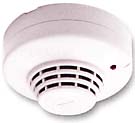
Smoke alarms are life-saving devices that provide benefits for occupants. They detect smoke well before any sleeping occupant would and provide critical seconds to implement actions to save life and property. Smoke alarms are designed to detect fire smoke and emit a loud and distinctive sound to alert occupants of potential danger.
Since September 1994 new homes in the ACT have been required to have mains-powered smoke alarms installed. It is also a requirement to have smoke alarms installed in home extensions that impact on sleeping and living areas.
Smoke alarms are mandatory in ALL dwellings in New South Wales, Victoria and South Australia. Evidence from the USA, where smoke alarms have been in wide use for 20 years, shows a reduction in house fire deaths of more than 50% in those homes where working smoke alarms are installed. The data available in Australia supports the USA figures.
If you have a working smoke alarm you are reducing the fire risk to yourself and your family and/or your tenants.
The NSW government introduced legislation on 1st May 2006 where ALL homes must have a smoke alarm. In some states this legislation already existed and other states are expected to follow.
Do I use battery operated or Mains connected smoke detectors?
Why use mains connected smoke detectors?
• The detector will still work (limited to no battery backup) if the batteries are not changed.
• Indicators and testers are powered by the mains and do not rely on the charge in the battery.
• They are connected to the mains power and use this power to sound the alarm.
• If desired, the detectors can be linked together if desired to activate other detector alarms and make the alarm sound throughout the house.
• Note: the battery should be changed each year to ensure operation if the power is lost.
Why use battery operated detectors?
• They are less expensive to install.
• Some form of smoke detection is better than none at all.
How many do I need?
A smoke alarm outside sleeping areas and on each additional level provides a reasonable degree of protection from the threat of fire. In a single-level home, two alarms are sufficient if all the bedrooms connect to a common passageway from the living areas.
Extra alarms will be required in homes with separate sleeping areas. Where occupants tend to sleep with doors closed, a smoke alarm should be installed in each bedroom, particularly if heaters or electrical appliances are used in those rooms.
Where should I put them?
This depends on the size and layout of your home.
Smoke alarms are required to be located so that they detect smoke before the smoke reaches the sleeping occupants. The sound level emitted by the smoke alarm is designed to wake sleeping occupants to give them time to escape from the building.
In residential dwellings, villas, townhouses, apartments and units etc, smoke alarms should be installed in every storey, as summarised below.
In storeys containing bedrooms, smoke alarms are to be located on or near the ceiling
* in every corridor or hallway associated with a bedroom, or
* if there is no corridor or hallway, between the part of the building containing the bedroom and the remainder of the building, dwelling or unit
A smoke alarm should be installed in every storey which does not contain bedrooms. In these storeys, a smoke alarm should be located in the path of travel in which the occupants will most likely take to escape from the building. This will ensure that the alarm is sounded before the smoke prevents the occupants from escaping from the building. If the bedrooms are located on the first floor or upper floor level, then the smoke alarm should be located near the area of the interconnecting stair.
For additional safety, building owners may also install smoke detectors within each bedroom.
For more information check out the Canberra Electrician Website.





